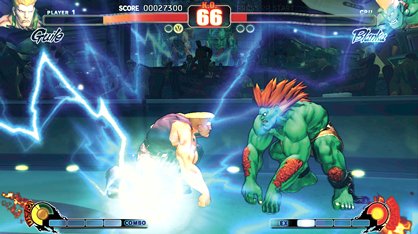PSM3 gives Street Fighter IV a 95!
The past, and future, of beat-em-ups
Familiarity, though, breeds anything but contempt. These are old friends to old blokes, and new heroes for a new generation. Where Street Fighter III was weighted towards a more hardcore crowd with new systems and an almost all-new cast, IV has been tested for months by dedicated arcade gamers across Japan, and for some fewer months by total amateurs here during every single lunch break and late shift. It’s proven to be as much fun for the new player as it is for the highest-level tournament players. For the first time in over a decade, Street Fighter has opened up its doors to everyone, with no gamer excluded.
For Street Fighter IV, complexity isn’t synonymous with depth. Its trick is in giving every player at every level a toolbox they can use, and making every tool flexible enough that it becomes an asset whether playing with your friends at home or at a tournament in LA.

Unlike Street Fighter III, Guilty Gear, or Virtua Fighter, Street Fighter IV doesn’t expect the world from your first minute of play. Instead it offers modes that coach you through its basics and complexities, gradually introducing concepts before letting you test them for yourself. It rewards you for every minuscule bit of progress you make – a new icon beside your name online, a new title below your name, new characters, new colours, new taunts – unlockables for every step forward and new skill learned.
First you’ll learn to throw a punch; then a kick; then a special move. You’ll learn to link regular strikes into specials, and specials into Supers and Ultras. You’ll chain a flying forward kick into a jab punch, strong punch, Dragon Punch, and cancel into Ultra combo. You’ll get better by the day. The training mode also explains the new Focus Attacks – hitting Medium Punch and Kick together lets you soak up one strike and deliver a hit of your own. It even explains how it can be used in combos to cancel out of special moves and transition into another move.
Every tool has a different use for every skill level. Focus, and you can hit opponents with a knock-down attack. Get your timing right, and that attack can be unblockable; learn how to cancel it with a dash, and you can charge a Focus, cancel it, and move forward without taking damage. At the highest levels, you can Focus in the middle of combos to link specials with Ultras and create ridiculous chains of attacks which would otherwise be broken easily.

The combo meters have also gotten tweaks to make them simpler whilst retaining depth. Dish out damage and you’ll build your Super bar; take damage and you’ll build your Ultra bar. Once either is full, you can unleash a devastating combination of attacks, just like Super Street Fighter II Turbo, the Alpha games, or SFIII.
But in separating the meters for dishing it out and soaking it up, Capcom have changed the dynamic of fights; suddenly, the player who’s taken the worst beating is the stronger of the two fighters. Where before the healthiest fighter could keep pressing the advantage on a weakened opponent, now the weaker fighter can strike back with an attack that will cost the stronger player a colossal chunk of his health bar.
Sign up to the GamesRadar+ Newsletter
Weekly digests, tales from the communities you love, and more


